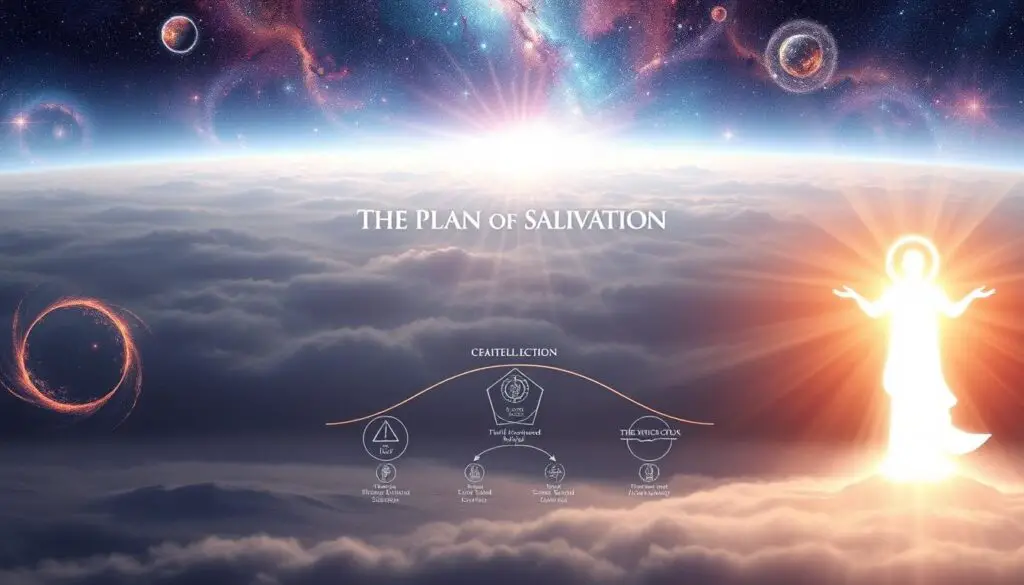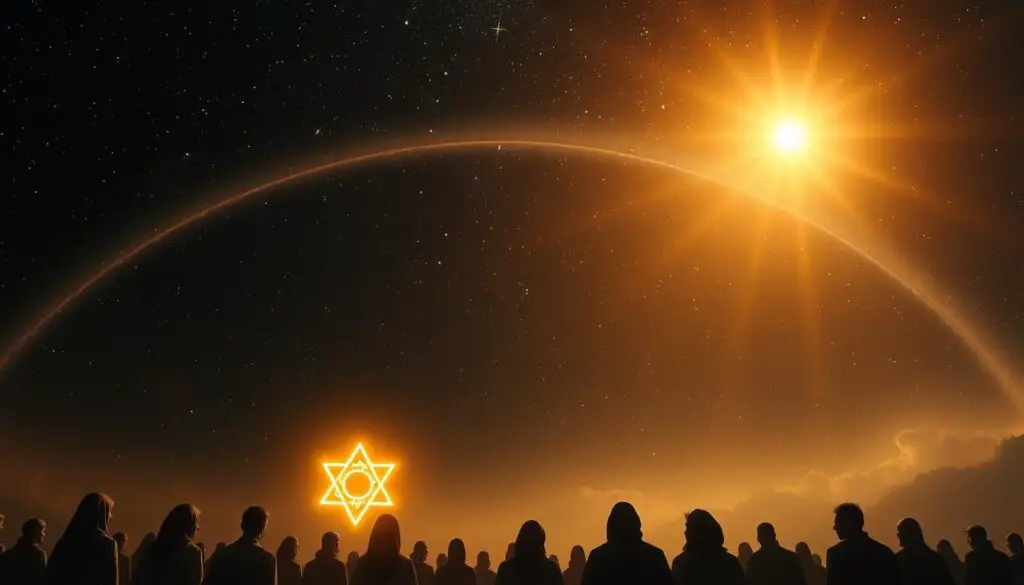Have you ever wondered about the unique teachings that shape Latter-day Saint beliefs about the universe? Central to their doctrine is the idea of Kolob, a heavenly body described in sacred texts as being closest to the throne of God. This concept, rooted in the Book of Abraham, offers a fascinating glimpse into how some faiths view creation, divine order, and humanity’s eternal potential.
The Book of Abraham, part of the Pearl of Great Price, was translated by Joseph Smith in the 19th century. It describes Kolob as a governing star or planet that oversees others in its system. For members of the Church of Jesus Christ of Latter-day Saints, this scripture provides insights into God’s relationship with the cosmos and humanity’s role within it.
This article will explore the historical roots of these teachings, clarify common questions, and address how they fit into broader beliefs about life, exaltation, and divine purpose. Whether you’re new to the topic or seeking deeper understanding, we’ll break down complex ideas in a friendly, approachable way.
Key Takeaways
- Kolob is described in Latter-day Saint scripture as the heavenly body nearest to God’s throne.
- The Book of Abraham is the primary source for teachings about Kolob and divine cosmology.
- Joseph Smith’s translations of ancient texts shaped these unique doctrinal perspectives.
- Beliefs about creation and exaltation connect closely to Latter-day Saint views of the universe.
- This article clarifies misconceptions and explains the cultural significance of these ideas.
Historical Origins and Scriptural Foundations
How did a collection of Egyptian scrolls become central to understanding heaven’s structure? The answer lies in Joseph Smith’s groundbreaking work during the 1830s-1840s. His translation of ancient papyri—purchased from a traveling exhibitor—formed the Book of Abraham, a text that reshaped Latter-day Saint views of divine order.
Joseph Smith and Sacred Translation
Using tools like the Urim and Thummim, Smith translated hieroglyphs into revelations about creation and celestial governance. The text describes Kolob as a “governing” body nearest to God’s throne. Early members saw this as literal truth, shaping their ideas about exaltation and humanity’s eternal potential.
Egyptian Roots, New Revelations
The Egyptian papyri included funeral texts and star charts. Smith interpreted these through a spiritual lens, linking them to biblical patriarch Abraham. Leaders like Brigham Young later taught that Kolob governed other stars—a concept blending ancient astronomy with prophetic vision.
This fusion of scripture and symbolism raised questions: Was Kolob a star or planet? The Book of Abraham uses both terms, reflecting its focus on divine hierarchy over scientific labels. For believers, it underscored God’s mastery over time, space, and human destiny.
Doctrine and Beliefs Surrounding Kolob
Is Kolob a physical star or a symbol of spiritual truths? The Book of Abraham describes it as the celestial body closest to God’s throne, sparking lively discussions among Latter-day Saints. These teachings blend scriptural detail with symbolic meaning, reflecting the Church’s unique approach to divine mysteries.

Literal Interpretations: Star or Planet?
Early leaders like Brigham Young taught that Kolob was a literal star governing others in its system. The Book of Abraham states it measures time “after the Lord’s manner” (Abraham 3:4), which some believers linked to scientific concepts. However, the text avoids modern astronomical labels, focusing instead on its role in God’s creative order.
Debates arose about whether Kolob was a planet or star. Joseph Smith’s translations used both terms, leaving room for personal understanding. This ambiguity reminds readers that scripture often prioritizes spiritual truths over technical precision.
Metaphorical Exegesis in Latter-day Saint Theology
Many see Kolob as a metaphor for Christ’s central role in salvation. Just as stars orbit brighter bodies, the Book of Abraham suggests souls progress toward divine light. One passage notes that “the Lord showed Abraham the intelligences that were organized before the world was” (Abraham 3:22), tying Kolob to humanity’s eternal potential.
This symbolic view aligns with teachings about exaltation—the belief that faithful individuals can become like God. Whether taken literally or figuratively, Kolob underscores a core Latter-day Saint idea: all creation points toward heavenly purpose.
Understanding the mormon planet in Modern Beliefs
How do ancient scriptures about celestial bodies translate to 21st-century faith? Today’s Latter-day Saints focus less on cosmic geography and more on the symbolic meaning behind these teachings. The idea of “getting one’s own planet,” often sensationalized in media, has evolved into a metaphor for creative partnership with God.
From Literal to Symbolic Understanding
Early teachings about Kolob sparked vivid imagery of divine worlds. Modern leaders emphasize its role as a spiritual compass rather than a physical location. As the Church clarifies, “Exaltation isn’t about ruling planets but becoming like our Heavenly Parents through Christ-like service.”
Recent essays from The Church of Jesus Christ of Latter-day Saints reframe the Book of Abraham’s teachings. They connect Kolob to eternal progression—the belief that humans can grow spiritually beyond mortality. This shift helps members see themselves as co-creators in God’s plan rather than future planetary landlords.
Popular culture often twists these doctrines into sci-fi tropes. Yet most members view them through lenses of family and personal growth. One believer notes, “It’s not about geography—it’s about learning to love and create as God does.” This perspective bridges Joseph Smith’s revelations with contemporary values of purpose and connection.
Interplay Between Science and Speculative Astronomy
What happens when ancient star maps meet modern telescopes? Early Latter-day Saint thinkers tried blending scriptural descriptions of Kolob with 19th-century astronomy. Leaders like Brigham Young saw it as a physical star governing others—a view mirroring how scientists then classified celestial bodies.
Ancient Astronomy Versus Contemporary Scientific Views
Joseph Smith’s translations described Kolob’s role in measuring time and creation. This matched ancient Egyptian star charts but clashed with later discoveries. For example, 1800s astronomers thought galaxies were nebulae—a mismatch with Kolob’s described centrality.
| Aspect | 19th-Century View | Modern Science |
|---|---|---|
| Kolob’s Location | Central governing star | Galactic center (black hole) |
| Time Measurement | “After the Lord’s manner” | Relativity-based spacetime |
| Role in Cosmos | Divine throne proximity | Gravitational systems |
Some scholars, like Skousen, speculated Kolob might align with our galaxy’s center. Yet today’s science shows galactic cores host black holes—not stars. This gap highlights how doctrine focuses on spiritual truths over astrophysical details.
Most Latter-day Saints now see these ideas symbolically. As one member shared, “Kolob reminds us God organizes all things—even if we don’t map heaven’s coordinates.” This balance lets faith and science coexist without conflict.
Joseph Smith’s Influence on Cosmological Teachings
Joseph Smith’s visionary work laid the foundation for how Latter-day Saints understand humanity’s place in the cosmos. His translations of ancient texts introduced ideas about divine order that still shape the Church’s teachings today. These revelations sparked both wonder and debate among early members.

Impact on Subsequent Leaders and Doctrinal Developments
Brigham Young famously expanded Smith’s teachings, describing Kolob as a literal star governing God’s creations. He taught that understanding celestial bodies helped members grasp their eternal potential. This emphasis on divine hierarchy became central to sermons about creation and purpose.
Later thinkers like B. H. Roberts explored symbolic meanings. He suggested Smith’s cosmology revealed spiritual truths about progression toward God. This balance of literal and metaphorical interpretation allowed doctrines to evolve while staying rooted in scripture.
The Book of Abraham’s descriptions of time and space influenced teachings about the afterlife. Leaders connected Kolob to concepts like exaltation, where faithful individuals participate in God’s creative work. As one 20th-century apostle noted, “We’re not just inheriting worlds—we’re learning to nurture souls.”
Today, these ideas remind Latter-day Saints of their belief in eternal growth. Whether seen as stars or symbols, Smith’s cosmological teachings continue inspiring reflection on humanity’s divine connections.
Cultural Representations Across Media
From sacred hymns to sci-fi epics, Kolob has inspired creative works that shape public imagination. These portrayals range from reverent reflections to playful adaptations, revealing how doctrinal ideas resonate beyond religious circles.
From Hymns to Broadway: Popular References
The 19th-century hymn “If You Could Hie to Kolob” remains a beloved exploration of eternal progression. Its lyrics ponder creation’s endless nature, asking, “Had I the heavens’ embroidered cloth… could I ever finish counting?” This poetic approach invites reflection rather than literal interpretation.
Modern productions like The Book of Mormon musical satirize the “get your own planet” idea through songs like “I Believe.” While exaggerated, these references highlight how Latter-day Saint cosmology captures mainstream curiosity. Even the “Kolob” name appears in folk bands and indie albums as a metaphor for divine mystery.
Television, Film, and the Battlestar Galactica Connection
Science fiction often borrows religious motifs, and Kolob’s influence shines in Battlestar Galactica. The show’s mythical planet “Kobol” mirrors Kolob’s role as humanity’s spiritual origin. Creator Ronald D. Moore confirmed the nod to Latter-day Saint teachings, blending theology with space opera drama.
Other shows like South Park parody Kolob-related doctrines, sometimes oversimplifying complex beliefs. Yet these portrayals spark conversations about how media shapes perceptions of faith. As one cultural critic noted, “Pop culture acts as both megaphone and funhouse mirror for religious ideas.”
| Work | Medium | Approach |
|---|---|---|
| “If You Could Hie to Kolob” | Hymn | Devotional reflection |
| The Book of Mormon Musical | Broadway | Satirical comedy |
| Battlestar Galactica | TV Series | Mythological homage |
These diverse representations show how Kolob transcends scripture to become a cultural touchstone. Whether through music or sci-fi allegory, it continues to inspire creativity—and occasional confusion—about Latter-day Saint beliefs.
Criticisms and Scholarly Analysis
How do ancient texts and modern scholarship collide in debates about Latter-day Saint teachings? The Book of Abraham and its descriptions of Kolob have faced scrutiny from historians, Egyptologists, and theologians. These discussions reveal tensions between faith, translation claims, and historical evidence.
Controversies Surrounding the Book of Abraham
Egyptologist Robert Ritner argues Joseph Smith’s translation doesn’t match the original papyri, which contain common funerary texts. Critics note the scrolls date to 1st-century Egypt—not Abraham’s lifetime. Fawn Brodie’s biography No Man Knows My History called the work “a blend of imagination and borrowed theology.”
Defenders like Hugh Nibley countered that Smith’s translation captured hidden meanings invisible to secular scholars. The Church acknowledges the papyri aren’t directly from Abraham but maintains their divine inspiration. As one essay states, “Truth comes through revelation, not just historical methods.”
Scholarly Perspectives on the Kolob Doctrine
Academic debates often question Kolob’s astronomical plausibility. Historian David Persuitte noted that 19th-century star lore influenced Smith’s cosmology. Others compare Kolob to ancient Near Eastern myths about divine councils and sacred mountains.
| Aspect | Criticisms | Defenses |
|---|---|---|
| Translation Validity | Papyri unrelated to Abraham | Symbolic or revelatory interpretation |
| Astronomical Claims | Reflects outdated science | Focus on spiritual hierarchy |
| Textual Origins | No ancient Hebrew/Egyptian parallels | Unique revelatory framework |
These discussions shape how Latter-day Saints engage with their history. While some members reinterpret Kolob metaphorically, others see critiques as tests of faith. As scholar Terryl Givens notes, “Sacred texts often thrive because of their mysteries, not despite them.”
Modern Interpretations and Evolving Perspectives
How do faith communities navigate modern myths while staying true to their roots? For Latter-day Saints, addressing media-driven stereotypes about celestial doctrines has become part of their spiritual dialogue. Recent years have seen intentional efforts to reframe misunderstood teachings through official channels and grassroots conversations.
Responses to Misconceptions and Media Portrayals
The phrase “get your own planet” often circulates in pop culture. Church leaders now clarify this oversimplification through official Q&A documents. One 2023 statement explains: “Exaltation isn’t about property—it’s about becoming like Jesus Christ through loving service.”
Social media plays a key role in reshaping perceptions. Many members share short videos explaining how doctrine focuses on family bonds over cosmic real estate. As one TikTok creator noted, “We believe in eternal growth, not planetary time-shares!”
| Misconception | Clarification |
|---|---|
| “Own a planet” | Co-create with God through Christ-like living |
| Literal star maps | Symbolic hierarchy emphasizing divine order |
| Isolated theology | Connection to Christian concepts of salvation |
Humor often bridges understanding gaps. When The Book of Mormon Musical jokes about planets, many believers laugh while sharing deeper truths. This balance helps correct myths without dismissing genuine curiosity.
Scholarship also influences modern views. As historical context about Joseph Smith’s translations becomes accessible online, members blend traditional beliefs with academic insights. The result? A faith that honors mystery while embracing thoughtful dialogue.
Conclusion
What connects ancient star charts with modern spiritual growth? This exploration reveals how Latter-day Saint teachings about divine order evolved from Joseph Smith’s translations of the Book of Abraham to today’s focus on eternal progression. Early ideas about celestial governance have shifted toward symbolic interpretations emphasizing spiritual growth over cosmic geography.
While pop culture often reduces these doctrines to caricatures, deeper study uncovers rich layers of meaning. The Book of Abraham invites reflection on humanity’s divine potential rather than physical planetary claims. Central to this theology is Jesus Christ, whose teachings guide believers toward compassionate service and eternal connection with God.
From historical debates to media portrayals, these ideas spark curiosity across generations. For those seeking clarity, returning to original scriptures and trusted sources offers the best path forward. Have questions? Let’s keep the conversation going—exploration thrives when we learn together.
FAQ
What is Kolob in Latter-day Saint beliefs?
Kolob is described in scripture as a star or heavenly body near where God resides. It symbolizes divine order and closeness to the Creator in Latter-day Saint teachings.
Did Joseph Smith teach that humans can become like God?
Yes, Joseph Smith taught that through obedience and exaltation, individuals can inherit divine potential, reflecting the belief in eternal progression central to Latter-day Saint doctrine.
How does the Book of Abraham relate to Kolob?
The Book of Abraham, translated by Joseph Smith, introduces Kolob as part of a broader cosmological framework tied to creation and God’s governance of the universe.
Do Latter-day Saints believe in multiple worlds or planets?
Yes, teachings suggest God governs countless worlds, and scripture emphasizes His creative power extending beyond Earth, though specifics remain symbolic rather than doctrinal mandates.
How does science view Kolob or related teachings?
These concepts are viewed as faith-based rather than scientific. They reflect ancient worldviews and are not interpreted as literal astronomy by most members today.
Why is Kolob referenced in pop culture like Battlestar Galactica?
Some media draw on Latter-day Saint cosmology for creative inspiration, though portrayals often simplify or fictionalize beliefs for storytelling purposes.
Are there controversies about the Book of Abraham’s origins?
Yes, scholars debate its ties to ancient Egyptian texts. The Church acknowledges these discussions but emphasizes its spiritual value over historical critiques.
How do modern members interpret Kolob?
Many focus on its symbolic meaning—such as God’s majesty and humanity’s eternal journey—rather than literal interpretations, aligning with broader shifts toward metaphor in theology.









